Eyespots on the dorsal fins of the twinspot goby are startling for the overlooked coexistence of a family of fierce crabs.

Prof. Mumblebard claims: “Like other ocellated animals, the twinspot goby uses its eyespots to simulate the staring disembodied eyes of an undisclosed animal larger than itself. This does not mimic any particular animal because it deters would-be predators mainly by confusion.”
Robin and the Honey Badger respond: “No biologist seems previously to have noticed that the twinspot goby resembles certain fierce crabs which share its habitat. The dark ventral fins of this fish suggest large pincers or the body shadow of a broad carapace, and its shuffling movement mimes not just crabs in general but portunid crabs in particular. Furthermore, the eyespots exaggerate the non-ocellated stalked eyes of the portunid crabs. This is likely to trick predators that are just smart enough to be gullible to errors of interpretation. The choice of model is likely to be effective. Portunid crabs are intimidating because they have long pincers and can swim towards an intruder instead of merely retreating or hunkering. The overall effect of the display of the twinspot goby is a sinister cartoon based on the principles of caricature and animation as used in puppet shows. Although this fish mimes no particular species and its mimicry is abstract, what it invokes is the specific threat of irascible crabs with a particular ability to lunge defensively, rather than the vague threat of a generalised stare.”

Please join us here at the Bio-edge with your own comments. In the discussion below we encourage links to any evidence supporting either Prof. Mumblebard or Robin and the Honey Badger. Illustrations are welcome but please cite all sources or we may be forced under copyright to delete your comment.
***
Featured image: Twin-spot Goby (Signigobius biocellatus) by Chika Watanabe (Flickr, CC BY 2.0, Twin-spot Goby)

